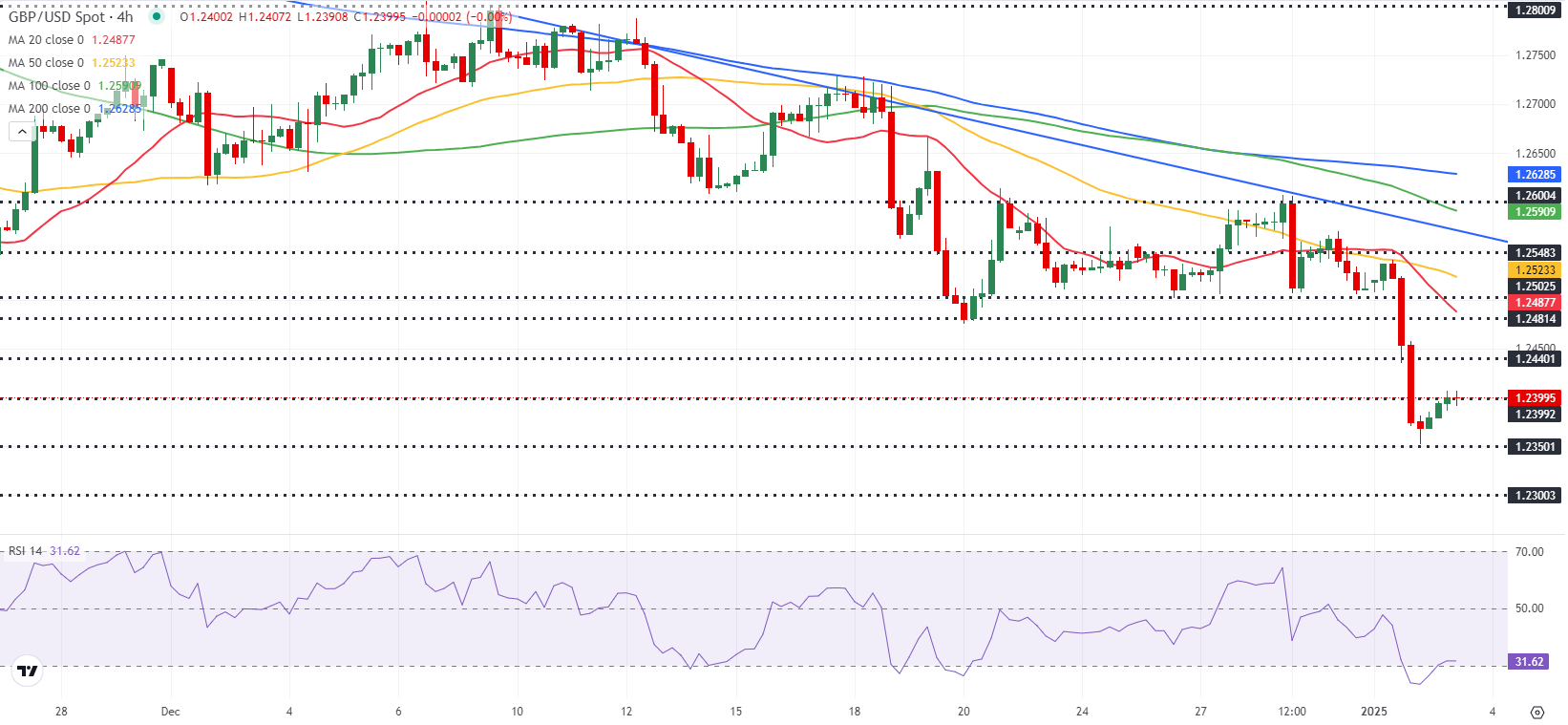- GBP/USD dropped to its lowest level since April near 1.2350 on Thursday.
- The pair struggles to stage a rebound in the European session on Friday.
- The technical outlook points to a bearish bias as investors await US PMI data.
GBP/USD declined sharply and touched its weakest level in nearly nine months at 1.2352 on Thursday. The pair rises toward 1.2400 in the European morning on Friday but shows no signs of a buildup in recovery momentum.
British Pound PRICE This week
The table below shows the percentage change of British Pound (GBP) against listed major currencies this week. British Pound was the weakest against the Japanese Yen.
| USD | EUR | GBP | JPY | CAD | AUD | NZD | CHF | |
|---|---|---|---|---|---|---|---|---|
| USD | 1.36% | 1.41% | -0.30% | -0.15% | 0.06% | 0.47% | 0.95% | |
| EUR | -1.36% | 0.04% | -1.68% | -1.54% | -1.35% | -0.92% | -0.46% | |
| GBP | -1.41% | -0.04% | -1.70% | -1.58% | -1.39% | -0.97% | -0.52% | |
| JPY | 0.30% | 1.68% | 1.70% | 0.14% | 0.41% | 0.92% | 1.31% | |
| CAD | 0.15% | 1.54% | 1.58% | -0.14% | 0.20% | 0.69% | 1.08% | |
| AUD | -0.06% | 1.35% | 1.39% | -0.41% | -0.20% | 0.43% | 0.90% | |
| NZD | -0.47% | 0.92% | 0.97% | -0.92% | -0.69% | -0.43% | 0.45% | |
| CHF | -0.95% | 0.46% | 0.52% | -1.31% | -1.08% | -0.90% | -0.45% |
The heat map shows percentage changes of major currencies against each other. The base currency is picked from the left column, while the quote currency is picked from the top row. For example, if you pick the British Pound from the left column and move along the horizontal line to the US Dollar, the percentage change displayed in the box will represent GBP (base)/USD (quote).
As trading volumes returned to normal levels following the New Year break, the US Dollar (USD) benefited from the cautious market mood and gathered strength against its major rivals. Additionally, the US Department of Labor reported that the weekly Initial Jobless Claims fell to 211,000 in the week ending December 28 from 220,000 in the previous week. This reading came in below the market expectation of 222,000 and further boosted the USD.
Early Friday, US stock index futures trade modestly higher on the day, limiting the USD's gains and helping GBP/USD find support for now.
In the second half of the day, the ISM will publish the Manufacturing Purchasing Managers Index (PMI) data for December. Investors expect the headline Manufacturing PMI to match November's print of 48.4. The USD could continue to outperform its rivals with a reading above 50.
Market participants will also pay close attention to the inflation component of the PMI report, the Prices Paid Index. The market expectation is for this data to rise to 51.7 from 50.3. A bigger-than-forecast increase could feed into expectations of a policy hold by the Federal Reserve at the next meeting and make it difficult for GBP/USD to hold its ground.
GBP/USD Technical Analysis
The Relative Strength Index (RSI) indicator on the 4-hour chart holds slightly above 30 after falling toward 20 late Thursday, confirming that the latest recovery attempt was a technical correction rather than the beginning of a reversal.
On the downside, 1.2350 (static level) aligns as first support before 1.2300 (static level) and 1.2250 (static level). In case GBP/USD manages to stabilize above 1.2400 (static level), 1.2440 (static level) could be seen as next resistance before 1.2485 (20-period Simple Moving Average).
Pound Sterling FAQs
The Pound Sterling (GBP) is the oldest currency in the world (886 AD) and the official currency of the United Kingdom. It is the fourth most traded unit for foreign exchange (FX) in the world, accounting for 12% of all transactions, averaging $630 billion a day, according to 2022 data. Its key trading pairs are GBP/USD, also known as ‘Cable’, which accounts for 11% of FX, GBP/JPY, or the ‘Dragon’ as it is known by traders (3%), and EUR/GBP (2%). The Pound Sterling is issued by the Bank of England (BoE).
The single most important factor influencing the value of the Pound Sterling is monetary policy decided by the Bank of England. The BoE bases its decisions on whether it has achieved its primary goal of “price stability” – a steady inflation rate of around 2%. Its primary tool for achieving this is the adjustment of interest rates. When inflation is too high, the BoE will try to rein it in by raising interest rates, making it more expensive for people and businesses to access credit. This is generally positive for GBP, as higher interest rates make the UK a more attractive place for global investors to park their money. When inflation falls too low it is a sign economic growth is slowing. In this scenario, the BoE will consider lowering interest rates to cheapen credit so businesses will borrow more to invest in growth-generating projects.
Data releases gauge the health of the economy and can impact the value of the Pound Sterling. Indicators such as GDP, Manufacturing and Services PMIs, and employment can all influence the direction of the GBP. A strong economy is good for Sterling. Not only does it attract more foreign investment but it may encourage the BoE to put up interest rates, which will directly strengthen GBP. Otherwise, if economic data is weak, the Pound Sterling is likely to fall.
Another significant data release for the Pound Sterling is the Trade Balance. This indicator measures the difference between what a country earns from its exports and what it spends on imports over a given period. If a country produces highly sought-after exports, its currency will benefit purely from the extra demand created from foreign buyers seeking to purchase these goods. Therefore, a positive net Trade Balance strengthens a currency and vice versa for a negative balance.
Information on these pages contains forward-looking statements that involve risks and uncertainties. Markets and instruments profiled on this page are for informational purposes only and should not in any way come across as a recommendation to buy or sell in these assets. You should do your own thorough research before making any investment decisions. FXStreet does not in any way guarantee that this information is free from mistakes, errors, or material misstatements. It also does not guarantee that this information is of a timely nature. Investing in Open Markets involves a great deal of risk, including the loss of all or a portion of your investment, as well as emotional distress. All risks, losses and costs associated with investing, including total loss of principal, are your responsibility. The views and opinions expressed in this article are those of the authors and do not necessarily reflect the official policy or position of FXStreet nor its advertisers. The author will not be held responsible for information that is found at the end of links posted on this page.
If not otherwise explicitly mentioned in the body of the article, at the time of writing, the author has no position in any stock mentioned in this article and no business relationship with any company mentioned. The author has not received compensation for writing this article, other than from FXStreet.
FXStreet and the author do not provide personalized recommendations. The author makes no representations as to the accuracy, completeness, or suitability of this information. FXStreet and the author will not be liable for any errors, omissions or any losses, injuries or damages arising from this information and its display or use. Errors and omissions excepted.
The author and FXStreet are not registered investment advisors and nothing in this article is intended to be investment advice.
Recommended Content
Editors’ Picks

AUD/USD stays firm near 0.6300 after strong Chinese exports data
AUD/USD is trading well bid near 0.6300 in Asian trades on Monday, opening the week on the front foot. Risk sentiment remains in a sweeter spot following the weekend's news of lower US tariffs on Chinese electronic supply chain and strong Chinese exports data for March. Tariffs talks will remain on the radar.

USD/JPY recovers to 143.00 amid volatile trading
USD/JPY is trimming losses to retake 143\.00 in Monday's Asian trading. The US Dollar pauses its latest leg down, with traders digesting Trump's tariff news from the weekend. However, the Fed-BoJ policy divergence expectations underpin the Japanese Yen, keeping the weight intact on the pair.

Gold retreats from record highs of $3,245 as US Dollar finds its feet
Gold is rereating from record highs of $3,245 early Monday, extending Friday's late pullback. Reducded demand for safe-havens and a broad US Dollar rebound undermine the yellow metal amid the news of not-so-steep US tariffs on China's semiconductors and electronics.

Bitcoin is on the verge of a breakout while Ethereum and Ripple stabilize
Bitcoin price approaches its key resistance level at $85,000 on Monday; a breakout indicates a bullish trend ahead. Ethereum and Ripple found support around their key levels last week, suggesting a recovery is in the cards.

Is a recession looming?
Wall Street skyrockets after Trump announces tariff delay. But gains remain limited as Trade War with China continues. Recession odds have eased, but investors remain fearful. The worst may not be over, deeper market wounds still possible.

The Best brokers to trade EUR/USD
SPONSORED Discover the top brokers for trading EUR/USD in 2025. Our list features brokers with competitive spreads, fast execution, and powerful platforms. Whether you're a beginner or an expert, find the right partner to navigate the dynamic Forex market.
